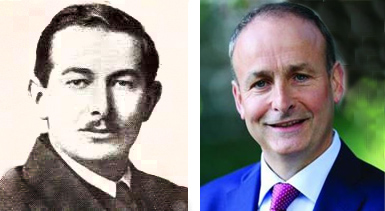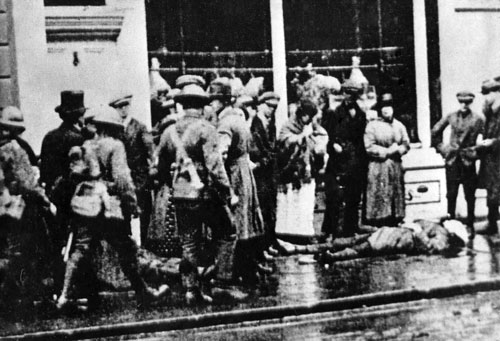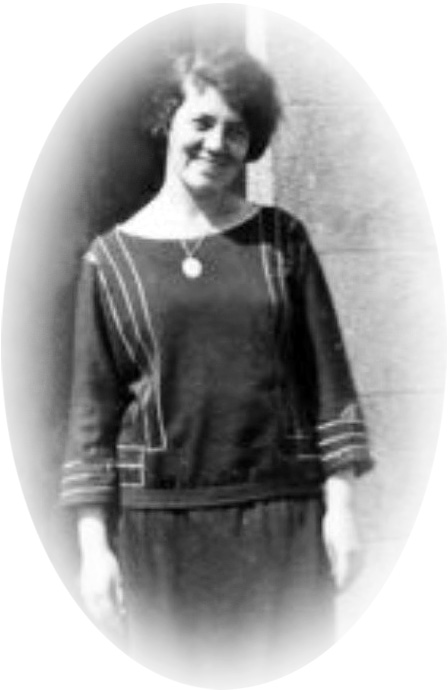
An Taoiseach Mr Micheál Martin, has remembered the life of Seán Treacy, latter one of the leaders of the 3rd Tipperary Brigade of the Irish Republican Army, during the Irish War of Independence; describing the Tipperary man as one of the great patriots of our revolution.
Mr Martin was speaking at the 101st Anniversary Commemoration of his death at his grave in Kilfeacle, Co. Tipperary.
Speech by An Taoiseach, Mr Micheál Martin TD, on the occasion of the 101st Anniversary Commemoration of the death of Seán Treacy, on Sunday 17th October 2021
“It is a great honour to stand with you in this place today, to remember the life of Seán Treacy, one of the great patriots of our revolution.
When the 3rd Tipperary Brigade Old IRA Commemoration Committee was formed 100 years ago those they sought to remember had only just left us. Their voices still resonated in the houses and hillsides of Tipperary – a tremendous source of pride and also of sadness about young lives cut short.
Their friends, families and colleagues were determined that they would not be forgotten – that generations to come would learn of their names, their sacrifices and their dramatic achievements.
They faced-down the military of the greatest empire the modern world would ever see – and they did this in the cause of inclusive republicanism.
The roll of honour of the 3rd Tipperary Brigade includes people from throughout this area and reflects the determination of the people of Tipp to take a lead.

Seán Treacy, who regularly deferred to others when appointments were being made, would be embarrassed to know that his name stands above those of his comrades. But this is inevitable because of how many roles he filled not just in 1919-1920, but in the organisations leading the national revival in the following years.
In a short 25 years he lived many lives – and it is no exaggeration to say that he reflected each of the elements which came together in the success of our revolution. The revolutionary generation was one inspired by language and culture – and dedicated to using education to achieve renewal.
Less than a lifetime after the national catastrophe and humiliation of the Famine, a new vision was being formed of a country with strong communities, a strong national culture and a belief in an Ireland which took its place amongst the nations of the world.
Treacy had the great fortune to be taught here in Tipperary by an exceptional personality, Cormac Breathnach – who was also known as Charlie Walsh. Into his class came Seán Treacy, Dinny Lacey, Dan Breen and Seán Hogan – leaving an indelible mark on them and in the future of our country.
Breathnach later became president of Conradh na Gaeilge, President of the INTO, Chairman of the Fianna Fáil Árd Comháirle, a TD and then Lord Mayor of Dublin. But even after holding all of these important roles, he always said that his proudest achievement was teaching these young men in Tipperary.
Treacy became an activist in Conradh na Gaeilge, joined the Volunteers and, at only 16, joined the IRB.
Everyone who met him saw him as a man of determination and action. It was only a coincidence that the action in Soloheadbeg took place on the same day as the first meeting of Dáil Éireann – but it was remarkably symbolic.
Alone of the many revolutions which Europe saw in those years, the Irish one not just military, it was also democratic, administrative and legal. Popular legitimacy was sought and repeatedly retained.
Fundamentally it was not a revolution about just repeating the methods of the past, it was about creating new realities and new possibilities for the Irish people.
In 1919 and 1920, the deeds of Seán Treacy inspired people throughout our island and abroad. The audacity of the rescue of Seán Hogan at Knocklong. The exploits of the Brigade’s flying column. The attempted ambush of Lord French and the escape from Fernside in Dublin, these and many more incidents made Seán Treacy and Co. Tipperary famous throughout the world, as symbols of a rising nation.
His tragic death in Talbot Street on 14th October 1920 cost us one of our finest, leaving us to wonder how much more he would have achieved had he lived.
Perhaps the most striking thing is that even while he was under almost inhuman pressure as the Crown Forces hunted him through Dublin, his focus was still on the future.

May Quigley was so saddened by the death of Sean Treacy that she left Ireland to start a new life in Australia.
Seán Treacy was due to marry May Quigley only days (11 days) after his shooting. We can only imagine how she felt, as their plans for building a life together in a new Ireland were shattered irrevocably. In his short 25 years on this earth Seán Treacy was a restless and determined figure. Improving himself, participating in a great cultural revival and then dedicating his life to his community and his country.
There is something wonderful and poignant about the commemoration which is held on Talbot Street every time Tipperary gets to the All-Ireland Final. On a festive day for the whole community, time is made to honour Treacy and what he represents. A community passionate about its sporting heroes of today, stops to remember its greatest hero of the past.
A modern community, at the forefront of many new technologies as well as innovative traditional industries, having the self-confidence required to pay respects to the giants on whose shoulders we all stand. I have always believed that it is up to each person to find their own connection with and understanding of our revolution. We owe it to them to those who sacrificed so much for us to understand their times and to continually renew the traditions which they personified. They both represented major international intellectual and cultural movements – and established our own distinct identity. They were not little-islanders as some have tried to say.
The state which we live in today is one of the oldest continuously democratic countries in the world. The national movement which Seán Treacy and the people of Tipperary played a leading role, was deeply international – and it was republican to its very core. The founding document of our revolution, the Proclamation of 1916, inspired so many because of the vision it presented of a diverse and inclusive nation. Ours was the only European revolution of that time which demanded that women play a full part in the political nation – and the only revolution which said that different traditions all form part of Irish identity.
Tipperary’s own Thomas MacDonagh was, just like so many others, inspired by the language movement – but his greatest work of literary criticism, one which is still taught in our universities today, insists on the unique Irish voice of literature written by Irish people in English.
The message of our revolution was of a people who wanted to work with other nations in a spirit of friendship. That is why in 1937, at a dark moment in world history the Irish people, led by the most senior survivor of the Rising, adopted in a free referendum a constitution which honoured international law and rejected the growth of extreme ideologies of the right and left.
If we want to know why Ireland is one of a handful of European countries to have avoided these violent extremes, all you have to do is look at our great revolutionary generation. With legitimacy from the communities they never lost touch with, and a commitment to a generous republicanism, they gave us a priceless inheritance. And of course, the final action of our great revolutionary generation was to set on the course for membership of what is now the European Union.
Like Treacy, Seán Lemass was only a teenager when he began to risk his all for his country – and as he headed towards retirement, he devoted his great energy to the cause of reconciliation on this island and securing our place as part of a powerful community of nations. And it is because we are positive Europeans that Europe has stood so steadfastly at our side as we all try to manage the impact of Brexit.
What we’ve seen in recent months and years is a remarkable willingness to engage with and respond to the views of the Irish people on all parts of our island. In 1998 we saw the triumph of a democratic republican vision of working for lasting reconciliation and peace on our island. For the first time in our history we created a shared vision of how to work together and how to deal with problems. From the very first moment the European Union has been a fully committed partner for peace. The Union has supported peace financially and it has shown a unique flexibility at every moment in terms of trying to protect and promote the Good Friday Agreement. Indeed, if you look at the text of the Agreement, you will find Europe mentioned repeatedly in terms of both North/South engagement and the operation of Northern Institutions.
Europe is in the DNA of the Agreement – a binding treaty which was ratified by two referendums and two sovereign parliaments. But equally, we have all accepted the reality of the decision of Brexit referendum, even though it was rejected by the people of Northern Ireland. This week the European Commission responded to the concerns of people in Northern Ireland in a comprehensive and ambitious way.
The package they have proposed manifestly provides the basis for concluding negotiations and getting back to the work of co-operation and development. The Irish people and the Irish government have demonstrated good faith at every stage. The European Commission has gone to exceptional lengths to demonstrate its good faith in responding to issues which were not of its making. If everyone demonstrates this good faith, then we can deal with this quickly and move on.
The people of this island have shown remarkable resilience and growth over the last century.
We have achieved incredible things, while always demanding of ourselves that we must do better. We have been able to do this because of a generation of men and women who committed themselves to renewal and a republican commitment to building a state which seeks to serve its people and build partnerships with others. Twenty five years were not enough to show us everything which Seán Treacy could achieve for the people he was so passionate about – but they were enough to mark him as a great Irishman and a great republican.
Some 101 years after he was shot down on a Dublin Street it is right that we continue to come to this place to honour him. To honour his comrades and to honour everything which they achieved for the Irish people”.
Speech Ends

Leave a Reply